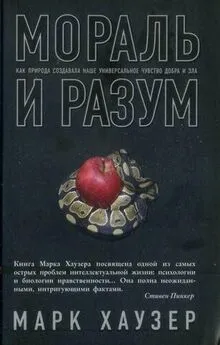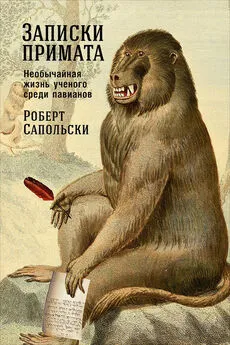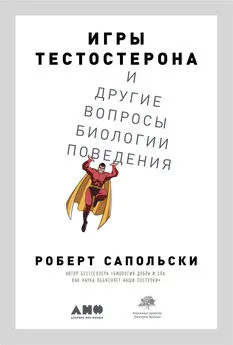Роберт Сапольски - Биология добра и зла. Как наука объясняет наши поступки
- Название:Биология добра и зла. Как наука объясняет наши поступки
- Автор:
- Жанр:
- Издательство:Альпина нон-фикшн
- Год:2019
- Город:Москва
- ISBN:978-5-0013-9051-0
- Рейтинг:
- Избранное:Добавить в избранное
-
Отзывы:
-
Ваша оценка:
Роберт Сапольски - Биология добра и зла. Как наука объясняет наши поступки краткое содержание
Биология добра и зла. Как наука объясняет наши поступки - читать онлайн бесплатно ознакомительный отрывок
Интервал:
Закладка:
827
G. E. Rice and P. Gainer, “‘Altruism’ in the Albino Rat,” J Comp and Physiological Psych 55 (1962): 123; J. S. Mogil, “The Surprising Empathic Abilities of Rodents,” TICS 16 (2012): 143; I. Ben-Ami Bartal et al., “Empathy and Pro-social Behavior in Rats,” Sci 334 (2011): 1427– 30.
828
I. B. A. Bartal et al., “Pro-social Behavior in Rats is Modulated by Social Experience,” eLife 3 (2014): e01385.
829
C. Lamm et al., “Meta-analytic Evidence for Common and Distinct Neural Networks Associated with Directly Experienced Pain and Empathy for Pain,” Neuroimage 54 (2011): 2492; B. C. Bernhardt and T. Singer, “The Neural Basis of Empathy,” Ann Rev Nsci 35 (2012): 1.
830
A. Craig, “How Do You Feel? Interoception: The Sense of the Physiological Condition of the Body,” Nat Rev Nsci 3 (2002): 655; J. Kong et al., “A Functional Magnetic Resonance Imaging Study on the Neural Mechanisms of Hyperalgesic Nocebo Effect,” J Nsci 28 (2008): 13354.
831
B. Vogt, “Pain and Emotion Interactions in Subregions of the Cingulate Gyrus,” Nat Rev Nsci 6 (2005): 533; K. Ochsner et al., “Your Pain or Mine? Common and Distinct Neural Systems Supporting the Perception of Pain in Self and Other,” SCAN 3 (2008): 144; отсюда взята цитата Окснера.
832
N. Eisenberger et al., “Does Rejection Hurt? An fMRI Study of Social Exclusion,” Sci 302 (2003): 290; D. Pizzagalli, “Frontocingulate Dysfunction in Depression: Toward Biomarkers of Treatment Response,” Neurophyschopharmacology 36 (2011): 183.
833
C. Lamm et al., “The Neural Substrate of Human Empathy: Effects of Perspective-Taking and Cognitive Appraisal,” J Cog Nsci 19 (2007): 42; P. Jackson et al., “Empathy Examined Through the Neural Mechanisms Involved in Imagining How I Feel Versus How You Feel Pain,” Neuropsychologia 44 (2006): 752; M. Saarela et al., “The Compassionate Brain: Humans Detect Intensity of Pain from Another’s Face,” Cerebral Cortex 17 (2007): 230; N. Eisenberg et al., “The Relations of Emotionality and Regulation to Dispositional and Situational Empathy-Related Responding,” JPSP 66 (1994): 776; J. Burkett et al., “Oxytocin-Dependent Consolation Behavior in Rodents,” Sci 351 (2016): 6271; M. Botvinick et al., “Viewing Facial Expressions of Pain Engages Cortical Areas Involved in the Direct Experience of Pain,” Neuroimage 25 (2005): 312; C. Lamm et al., “The Neural Substrate of Human Empathy: Effects of Perspective-Taking and Cognitive Appraisal,” J Cog Nsci 19 (2007): 42; C. Lamm et al., “What Are You Feeling? Using Functional Magnetic Resonance Imaging to Assess the Modulation of Sensory and Affective Responses During Empathy for Pain,” PLoS ONE 2 (2007): e1292.
834
D. Jeon et al., “Observational Fear Learning Involves Affective Pain System and Ca(v)1.2 Ca2+ Channels in ACC,” Nat Nsci 13 (2010): 482.
835
A. Craig, “How Do You Feel – Now? The Anterior Insula and Human Awareness,” Nat Rev Nsci 10 (2009): 59; B. King-Casas et al., “The Rupture and Repair of Cooperation in Borderline Personality Disorder,” Sci 321 (2008): 806; M. H. Immordino-Yang et al., “Neural Correlates of Admiration and Compassion,” PNAS 106 (2009): 8021.
836
J. Decety and K. Michalska, “Neurodevelopmental Changes in the Circuits Underlying Empathy and Sympathy from Childhood to Adulthood,” Developmental Sci 13 (2009): 886; J. Decety, “The Neuroevolution of Empathy,” ANYAS 1231 (2011): 35; цитата приведена по второму источнику.
837
E. Brueau et al., “Distinct Roles of the ‘Shared Pain’ and ‘Theory of Mind’ Networks in Processing Others’ Emotional Suffering,” Neuropsychologia 50 (2012): 219; C. Lamm et al., “How Do We Empathize with Someone Who Is Not Like Us? A Functional Magnetic Resonance Imaging Study,” J Cog Nsci 22 (2010): 362; C. Keysers et al., “Somatosensation in Social Perception,” Nat Rev Nsci 11 (2010): 417.
838
L. Harris and S. Fiske, “Dehumanizing the Lowest of the Low: Neuroimaging Responses to Extreme Outgroups,” Psych Sci 17 (2006): 847.
839
I. Konvalinkha et al., “Synchronized Arousal Between Performers and Related Spectators in a Fire-Walking Ritual,” PNAS 108 (2011): 8514; Y. Cheng et al., “Love Hurts: An fMRI Study,” NeuroImage 51 (2010): 923.
840
A. Avenanti et al., “Transcranial Magnetic Stimulation Highlights the Sensorimotor Side of Empathy for Pain,” Nat Nsci 8 (2005): 955; X. Xu et al., “Do You Feel My Pain? Racial Group Membership Modulates Empathic Neural Responses,” J Nsci 29 (2009): 8525; V. Mathur et al., “Neural Basis of Extraordinary Empathy and Altruistic Motivation,” NeuroImage 51 (2010): 1468; G. Hein et al., “Neural Responses to Ingroup and Outgroup Members’ Suffering Predict Individual Differences in Costly Helping,” Neuron 68 (2010): 149; E. Bruneau et al., “Social Cognition in Members of Conflict Groups: Behavioural and Neural Responses in Arabs, Israelis and South Americans to Each Other’s Misfortunes,” Philosophical Transactions of the Royal Soc B 367 (2012): 717; E. Bruneau and R. Saxe, “Attitudes Towards the Outgroup are Predicted by Activity in the Precuneus in Arabs and Israelis,” NeuroImage 52 (2010): 1704; J. Gutsell and M. Inzlicht, “Intergroup Differences in the Sharing of Emotive States: Neural Evidence of an Empathy Gap,” SCAN 10 (2011): 1093; J. Freeman et al., “The Neural Origins of Superficial and Individuated Judgments About Ingroup and Outgroup Members,” Hum Brain Mapping 31 (2010): 150.
841
К сноске: K. Wailoo, Pain: A Political History (Baltimore, MD: Johns Hopkins University Press, 2014).
842
C. Oveis et al., “Compassion, Pride, and Social Intuitions of Self-Other Similarity,” JPSP 98 (2010): 618; M. W. Kraus et al., “Social Class, Contextualism, and Empathic Accuracy,” Psych Sci 21 (2012): 1716; J. Stellar et al., “Class and Compassion: Socioeconomic Factors Predict Responses to Suffering,” Emotion 12 (2012): 449; P. Piff et al., “Higher Social Class Predicts Increased Unethical Behavior,” PNAS 109 (2012): 4086.
843
J. Gutsell and M. Inzlicht, “Intergroup Differences in the Sharing of Emotive States: Neural Evidence of an Empathy Gap,” SCAN 10 (2011): 1093; H. Takahasi et al., “When Your Gain Is My Pain and Your Pain Is My Gain: Neural Correlates of Envy and Schadenfreude,” Sci 323 (2009): 890; T. Singer et al., “Empathic Neural Responses Are Modulated by the Perceived Fairness of Others,” Nat 439 (2006): 466; S. Preston and F. de Waal, “Empathy: Its Ultimate and Proximate Bases,” BBS 25 (2002): 1.
844
C. N. Dewall et al., “Depletion Makes the Heart Grow Less Helpful: Helping as a Function of Self-Regulatory Energy and Genetic Relatedness,” PSPB 34 (2008): 1653. Мать Тереза цитируется по: P. Slovic, “‘If I Look At the Mass, I Will Never Act’: Psychic Numbing and Genocide,” Judgment and Decision Making, 2 (2007): 1. Цитата приписывается Сталину в многочисленных источниках, в том числе: L. Lyons, “Looseleaf Notebook,” Washington Post, January 30, 1947.
845
A. Jenkins and J. Mitchell, “Medial Prefrontal Cortex Subserves Diverse Forms of Self-Reflection,” Soc Nsci 6 (2011): 211.
846
G. Di Pellegrino et al., “Understanding Motor Events: A Neurophysiological Study,” Exp Brain Res 91 (1992): 176; G. Rizzolatti et al., “Premotor Cortex and the Recognition of Motor Actions,” Cog Brain Res 3 (1996): 131; см. также: P. Ferrari et al., “Mirror Neurons Responding to the Observation of Ingestive and Communicative Mouth Actions in the Ventral Premotor Cortex,” Eur J Nsci 17 (2003): 1703; G. Rizzolatti and L. Craighero, “The Mirror-Neuron System,” Ann Rev Nsci 27 (2004): 169.
847
К сноске: P. Molenberghs et al., “Is the Mirror Neuron System Involved in Imitation? A Short Review and Meta-analysis,” Nsci and Biobehavioral Reviews 33 (2009): 975.
848
МРТ-исследования человека: V. Gazzola and C. Keysers, “The Observation and Execution of Actions Share Motor and Somatosensory Voxels in All Tested Subjects: Single-Subject Analyses of Unsmoothed fMRI Data,” Cerebral Cortex 19 (2009): 1239; M. Iacoboni et al., “Cortical Mechanisms of Human Imitation,” Sci 286 (1999): 2526. Записи одиночных нейронов у людей: C. Keysers and V. Gazzola, “Social Neuroscience: Mirror Neurons Recorded in Humans,” Curr Biol 20 (2010): R353; J. Kilner and A. Neal, “Evidence of Mirror Neurons in Human Inferior Frontal Gyrus,” J Nsci 29 (2009): 10153.
849
M. Rochat et al., “The Evolution of Social Cognition: Goal Familiarity Shapes Monkeys’ Action Understanding,” Curr Biol 18 (2008): 227; M. Lacoboni, “Grasping the Intentions of Others with One’s Own Mirror Neuron System,” PLoS Biol 3 (2005): e79.
850
C. Catmur et al., “Sensorimotor Learning Configures the Human Mirror System,” Curr Biol 17 (2007): 1527.
851
G. Hickok, “Eight Problems for the Mirror Neuron Theory of Action Understanding in Monkeys and Humans,” J Cog Nsci 7 (2009): 1229.
852
V. Gallese and A. Goldman, “Mirror Neurons and the Simulation Theory,” TICS 2 (1998): 493.
853
V. Caggiano et al., “Mirror Neurons Differentially Encode the Peripersonal and Extrapersonal Space of Monkeys,” Sci 324 (2009): 403.
854
V. Gallese et al., “Mirror Neurons,” Perspectives on Psych Sci 6 (2011): 369.
855
Подборка статей по теме: L. Oberman et al., “EEG Evidence for Mirror Neuron Dysfunction in Autism Spectrum Disorders,” Brain Res: Cog Brain Res 24 (2005): 190; M. Dapretto et al., “Understanding Emotions in Others: Mirror Neuron Dysfunction in Children with Autism Spectrum Disorders,” Nat Nsci 9 (2006): 28; I. Dinstein et al., “A Mirror Up to Nature,” Curr Biol 19 (2008): R13; A. Hamilton, “Reflecting on the Mirror Neuron System in Autism: A Systematic Review of Current Theories,” Developmental Cog Nsci 3 (2013): 91.
856
G. Hickok, The Myth of Mirror Neurons: The Real Neuroscience of Communication and Cognition (New York: Norton, 2014).
Читать дальшеИнтервал:
Закладка:





![Роберт Сапольски - Игры тестостерона и другие вопросы биологии поведения [litres]](/books/1074102/robert-sapolski-igry-testosterona-i-drugie-vopros.webp)




